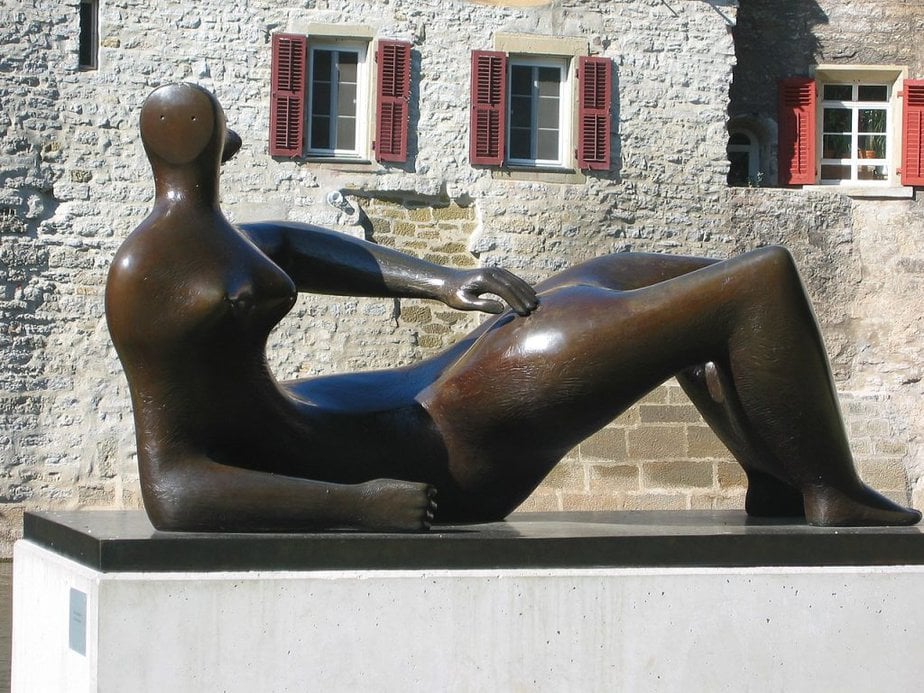Henry Moore (1898-1986) was a renowned British sculptor celebrated for his pioneering contributions to modern art.
His distinctive style featured organic, abstract forms that often explored the human figure and natural elements.
Moore’s work encompassed a wide range of materials, from bronze to stone, and continues to influence contemporary sculpture worldwide.
He’s celebrated for abstract, organic forms that harmonize human figures with nature, reflecting his belief in the intrinsic connection between art and the environment.
Moore’s sculptures, often carved from stone or cast in bronze, embrace the interplay of space and mass.
His philosophy emphasized accessibility, as he aimed to make art part of public spaces, challenging the notion of art confined to galleries.
Moore’s cultural impact transcends borders, shaping contemporary sculpture, and affirming his role as one of the 20th century’s most influential artists.
Reclining Figure
Henry Moore’s Reclining Figure series, spanning from the 1930s to the 1980s, is a testament to his mastery in sculpting the human form.

These iconic works, often in bronze, celebrate the sensuous curves of reclining figures, evoking themes of vulnerability and repose. Moore’s sculptures seamlessly blend abstraction with the timeless beauty of the human body.
Large Two Forms
Large Two Forms (1966) by Henry Moore is a monumental bronze sculpture featuring two abstract, interlocking forms.

This striking piece reflects Moore’s unique ability to create harmonious compositions that blur the lines between figuration and abstraction.
It invites viewers to contemplate the relationship between these organic, curvaceous shapes, embodying a sense of unity and connection.
Mother and Child series
Henry Moore’s Mother and Child series, created over several decades, focuses on the maternal bond and the tender interaction between mother and child.

These sculptures, in various materials, explore the timeless themes of protection, nurturing, and the fundamental human connection, showcasing Moore’s deep appreciation for the universality of these relationships.
Helmet Head and Shoulders
Helmet Head and Shoulders (1950) by Henry Moore is an abstract bronze sculpture, showcasing a fragmented human figure.

The work explores the interplay between solid and void, emphasizing the form’s contour.
Moore’s mastery in abstract representation is evident in this piece, which embodies his innovative approach to the human form in sculpture.
Stringed Figure
Stringed Figure (1937) is an abstract bronze sculpture by Henry Moore. This artwork features a dynamic, sinuous form with strings, reflecting the influence of modernist and surrealist movements.

Moore’s Stringed Figure embodies his innovative approach to sculpture, with a blend of organic and abstract elements, capturing a sense of fluidity and movement.
Draped Seated Woman
Draped Seated Woman (1957-58) by Henry Moore is a bronze sculpture in his exploration of draped figures.

The artwork showcases a seated female form enveloped in flowing drapery, creating a sense of both mystery and monumentality.
Moore’s sculpture elegantly captures the interplay between the human body and its surrounding environment, highlighting his mastery in conveying form and emotion.
Working Model for Sheep Piece
Working Model for Sheep Piece (1971) by Henry Moore is an abstract sculpture exploring animal forms.

Crafted in bronze, this piece is part of Moore’s fascination with nature and organic shapes. It reflects the artist’s innovative approach, capturing the essence of animals while maintaining an abstract, sculptural style.
The Arch
The Arch (1963-69) by Henry Moore is a monumental bronze sculpture characterized by open, curvaceous shapes.

This abstract and colossal artwork showcases Moore’s ability to create harmonious forms, inviting viewers to walk through and experience the sculpture’s space.
“The Arch” embodies Moore’s unique blend of abstraction and humanistic forms within a monumental structure.


